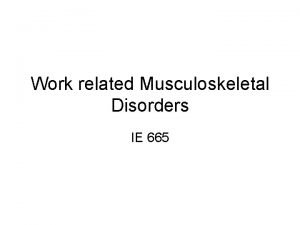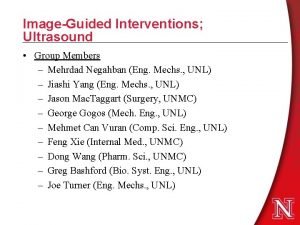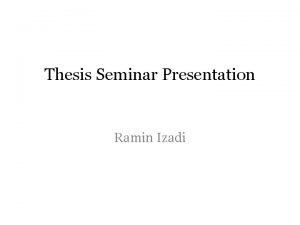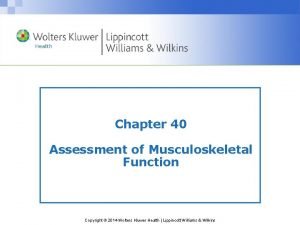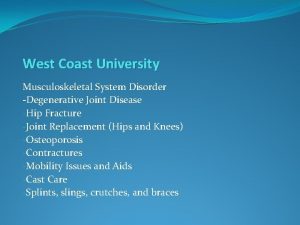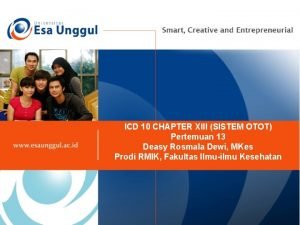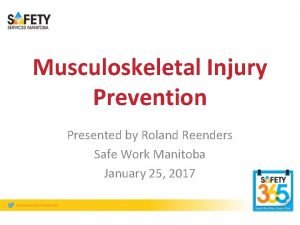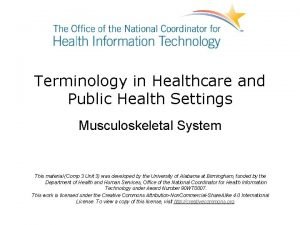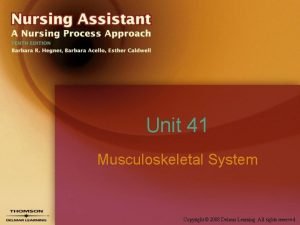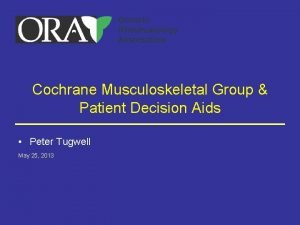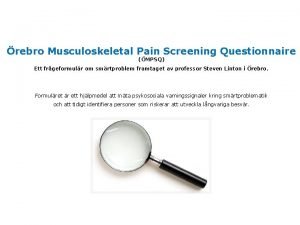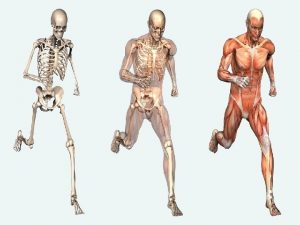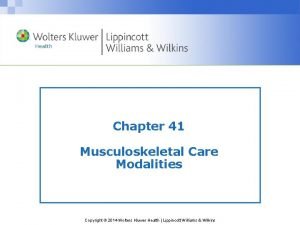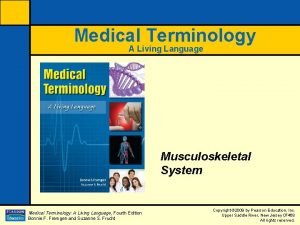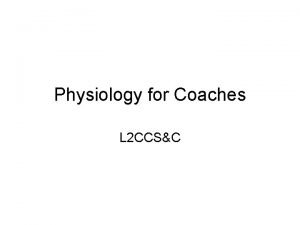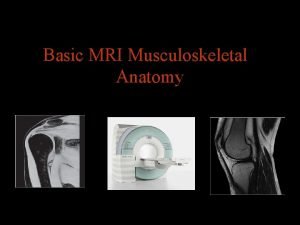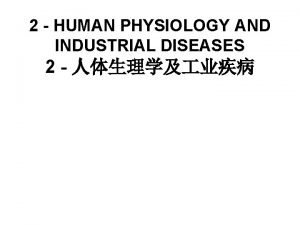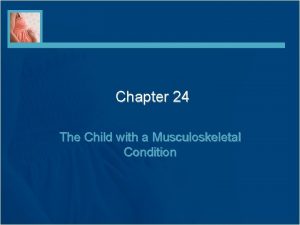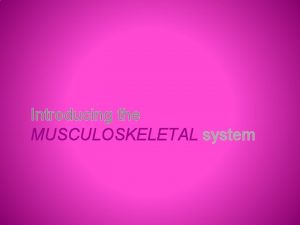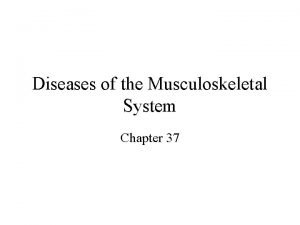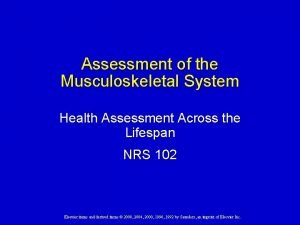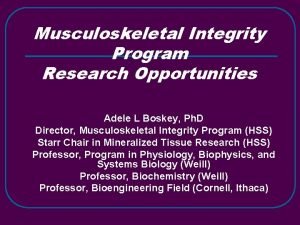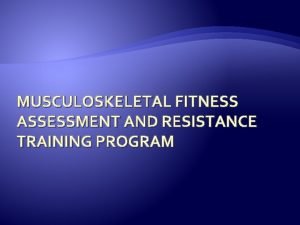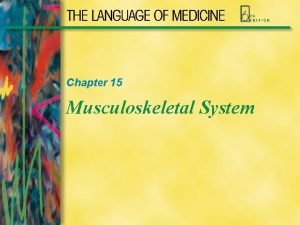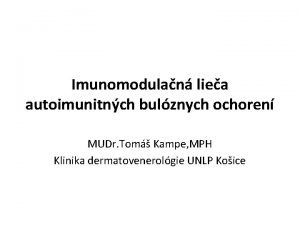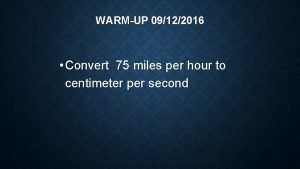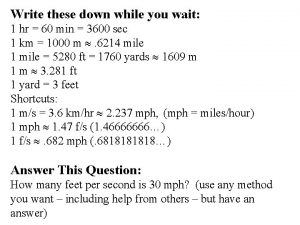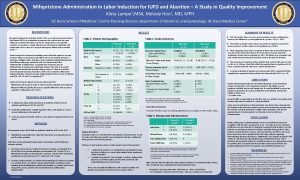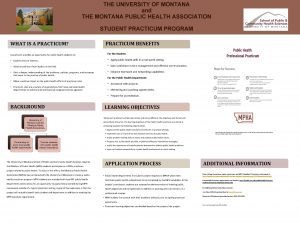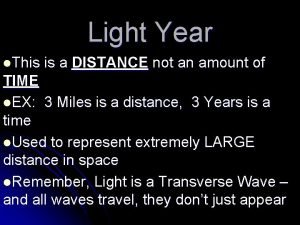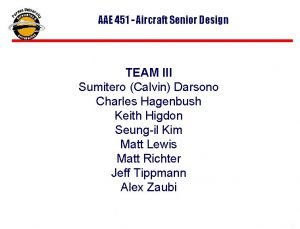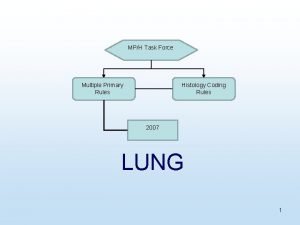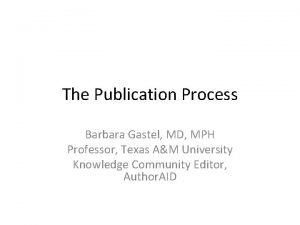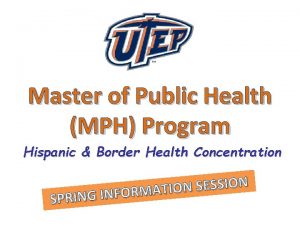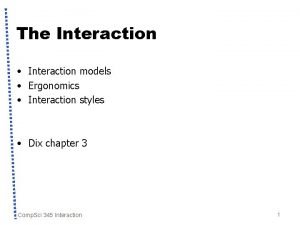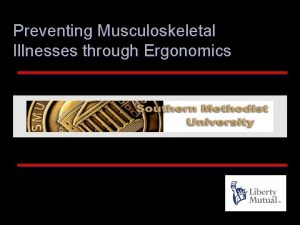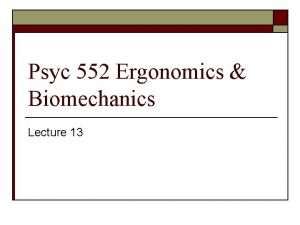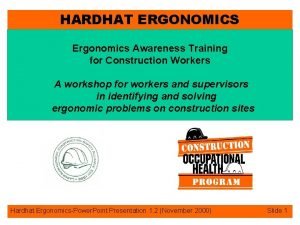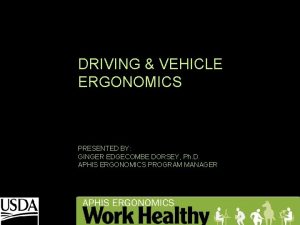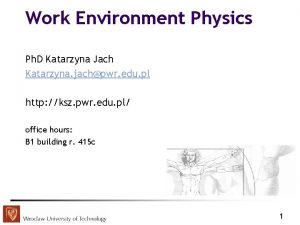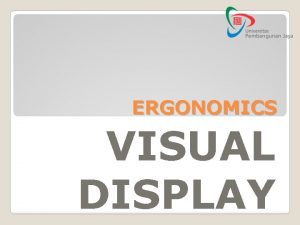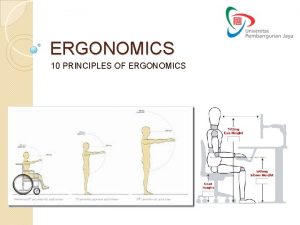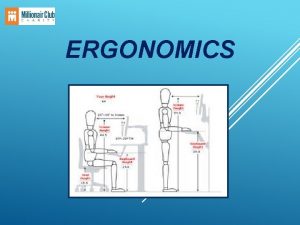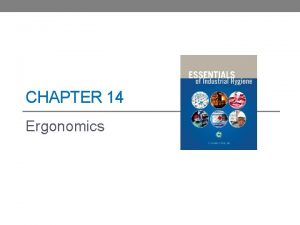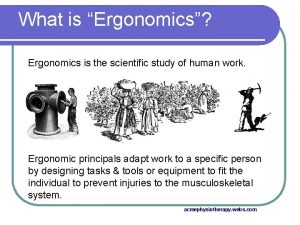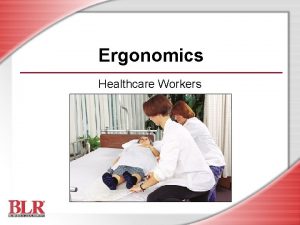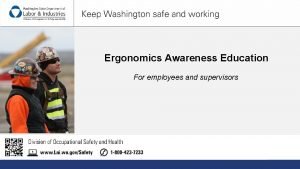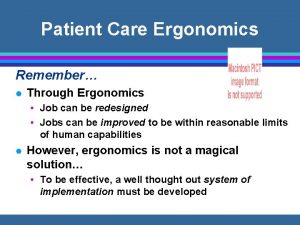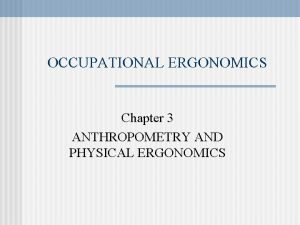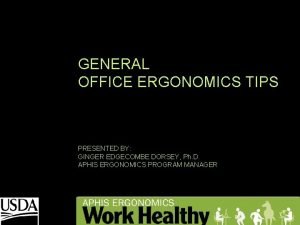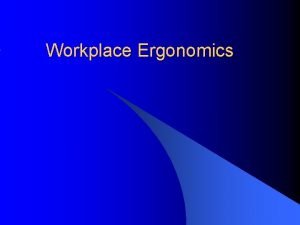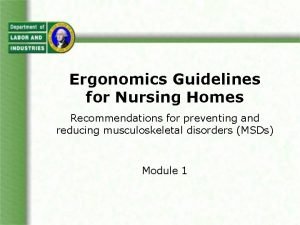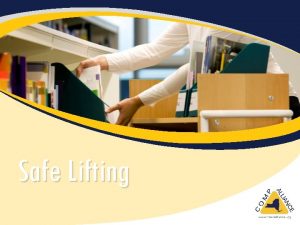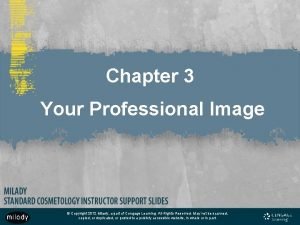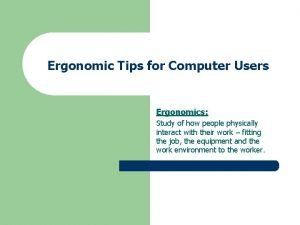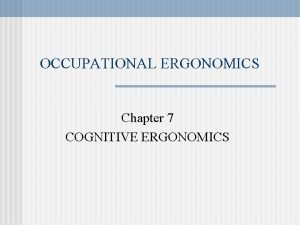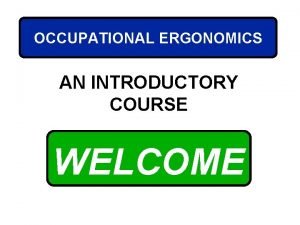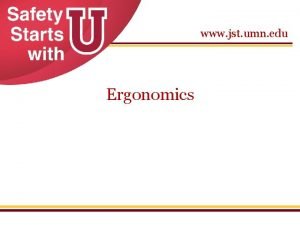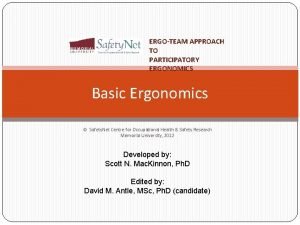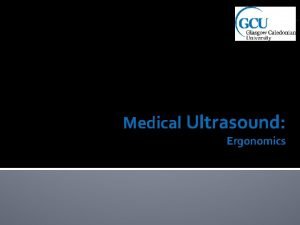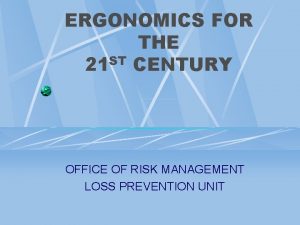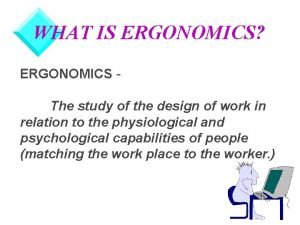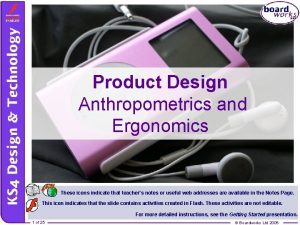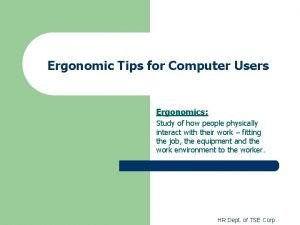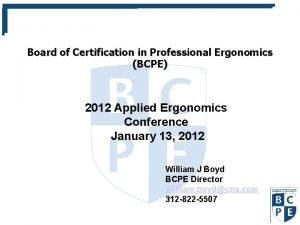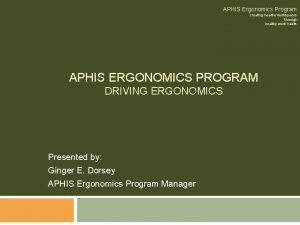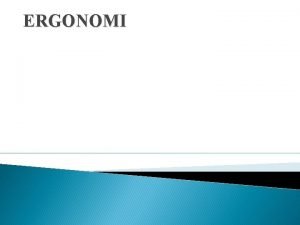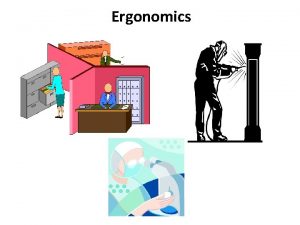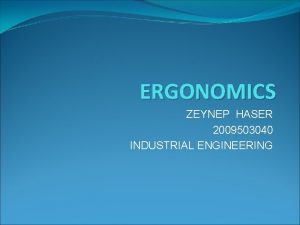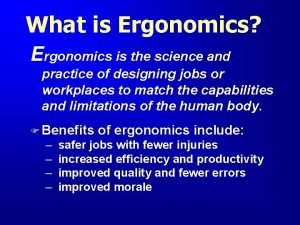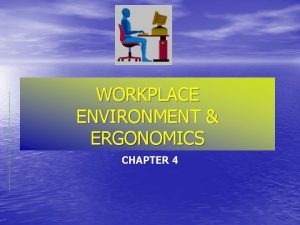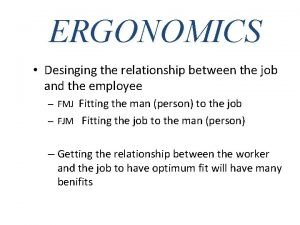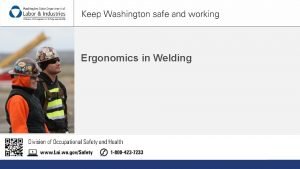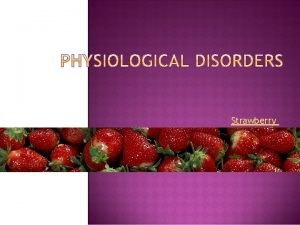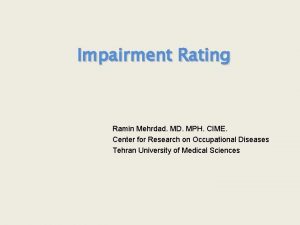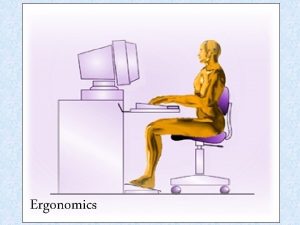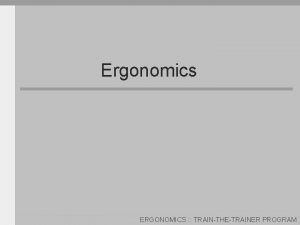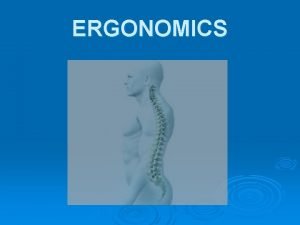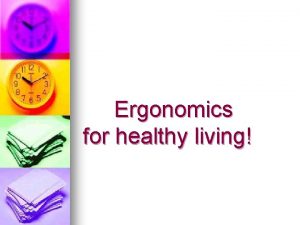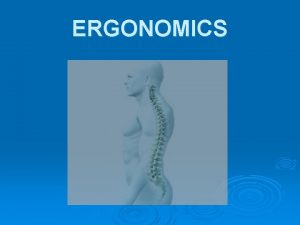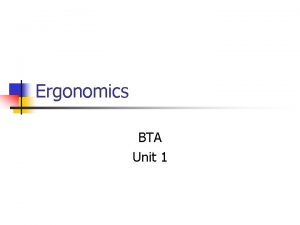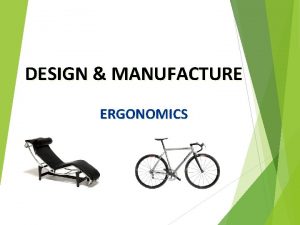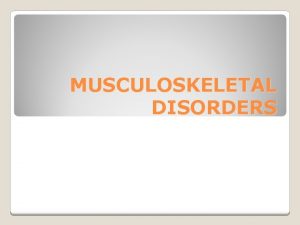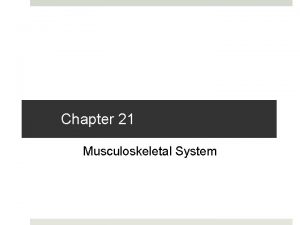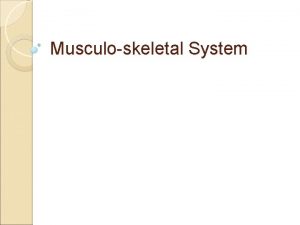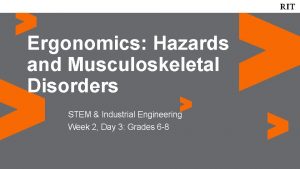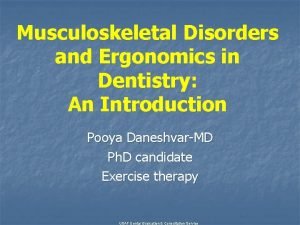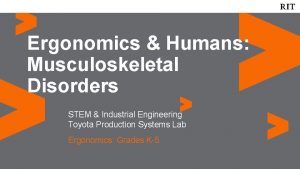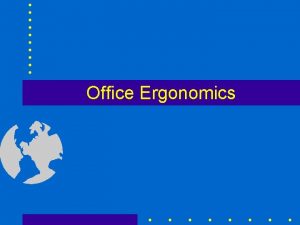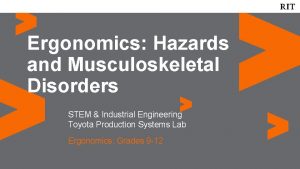Ergonomics Musculoskeletal Disorders Ramin Mehrdad MD MPH Center


















































































































- Slides: 114

Ergonomics & Musculoskeletal Disorders Ramin Mehrdad MD. MPH. Center for Research on Occupational Diseases (CROD) Tehran University of Medical Sciences (TUMS)

What is ergonomics?

Ergonomics: Ø Derived from two Greek words: �“Ergon” meaning work �“Nomoi” meaning natural laws Ø human factors engineering Ø the study of the physical and cognitive demands of work to ensure a safe and productive workplace.

Ergonomics: �The study of the physical & cognitive demands of work to ensure a safe and productive workplace

Ergonomics: �Ergonomics is the science and practice of designing jobs and workplaces to match the capabilities and limitations of the human body. �Ergonomics means “fitting the job to the worker”

Approach to Prevention of Occupational Injuries �Health professionals should: q tour work q familiarize themselves with job procedures, equipment, and working conditions. q job redesign: job simplification or job enlargement

Components of an ergonomics program


Cost-Effectiveness of Preventive Activities �Management support is critical for success �initial trainings may lead to increased injury reports �but long-term impact of ergonomics programs reduce the overall costs and severity of workrelated injuries �payback period of less than 1 year

Occupational Musculoskeletal Disorders (MSDs) Material Safety Data Sheet (MSDS)

Musculoskeletal Disorders (MSDs) �Muscles �Tendons �Ligaments �Bones �Nerves �Blood Vessels �Disks

PHYSICAL RISK FACTORS ASSOCIATED WITH MSDs �The NIOSH and the National Academy of Sciences have reviewed the physical stressors or risk factors that are associated with upper extremity and neck disorders and low-back pain.

ACGIH_HAL NIOSH Lifting Equation The Strain Index

WORKSTATION DESIGN PRINCIPLES

Reduce Sustained Awkward Postures q Work should be designed to prevent sustained : Ø Ø Ø • Neck or trunk flexion, extension, or rotation • Squatting • Shoulder elevation, abduction, flexion or external rotation • Elbow flexion • Wrist extension, flexion or ulnar or radial deviation • Finger extension or abduction

These risk factors for upper extremity are: • The application of sustained or high forces • Sustained awkward postures • Rapid, repeated motions • Contact stress • Vibration • Cold environment


Reduce Contact Stress q support surfaces should be rounded and padded to minimize the risk of contact stress and located on sensitive body regions (rist or elbow). Forearm support for sustained work at the computer

Reduce contact stress

Anthropometry

Design Work Based on Anthropometric Data q mismatch in size between the worker and the workplace, equipment, or tools = work related MSD Ø prolonged forward bending to reach for tools or materials Ø having to hold a heavy tool at some distance from the body Ø having to sit in a position that is too low or too high for the hands.

People Are Different Age Differences Height Differences

11 June 2021 Hamed Akbari Industrial Hygienist 23







Body dimensions for men & women


Forearm-only (preferable) and full-arm (satisfactory) reach limits for men and women in working areas shown in the horizontal and vertical planes.





Too low Too high Too far away

Avoid high and low object placement, especially as the weight and/or size of the object increases. Too high Too low


Logically Locate Controls & Displays q Primary controls _forearm-only reach limits and between the shoulders q infrequently used controls _full-arm reach limits


Proper Design of Chairs



Declined Sitting Reclined Sitting

Upright Sitting Standing

Seat pan length adjustment Seat Pan






Proper Selection of Chairs

The Desk 75 °- 135 °

Avoid Static Body Positions: Task Variation

Break Time

COMPUTER WORKSTATIONS Computer operators often complain of: Ø pain and fatigue in the neck, upper back, shoulders, forearms, or wrists Ø visual fatigue or eyestrain

Adjust Chair First The sitting posture during work can vary from forward sitting (visually demanding task) to upright sitting, reclined sitting (writing computer code), or standing.

Proper Placement of Monitor & Documents

q. Primary visual targets should be between 0 to 30 degrees below eye level q. Bifocal lens users need the primary display 30 to 45 degrees below eye level and may benefit from prescription monofocal or occupational bifocal lenses


Eliminate Glare The computer monitor should be positioned so that glare is minimized: 1. the bright light source the side of or above the computer user 2. Reduce the general illumination in the room to about 500 lux. 3. Provide more illumination where needed with desk lamps 4. use glare-reducing filters on computer screens


Position of Input Devices q The height of keyboard and pointing device should be adjusted so that the shoulders are not elevated and the wrists are relatively straight during use q Alternative keyboards or pointing devices can reduce awkward wrist and forearm postures

Pointing Devices

Type of Keyboards Mini Keyboards


Bad Good


Good Bad Mouse wrist rest



HAND TOOL DESIGN & SELECTION Reduce Hand Force: Ø The repeated high-pinch force or grip power tools is associated with tendon disorders of the forearm, muscle fatigue, and carpal tunnel syndrome

Pinching with the fingertips Gripping with the whole hand

Sustained or repeated pinch grip puts tendons at even greater risk than a power grip. Tools can be redesigned to convert use from a pinch grip to a power grip

Avoid Static Holding Positions Ø Heavy parts can be held with a jig or clamp so that the nondominant hand is not applying a constant grip force

When sustained holding is still necessary, the tool can be suspended from cables with a balancing system or articulated with antitorque bars to decrease grip force Tool Balancer

• Avoid Use of the Hand as a Tool • Proper Design of Tool Handles


BIOMECHANICS OF LIFTING, PUSHING, & PULLING


A commonly repeated safety rule is to “lift with the legs” and keep the load close to the body

q. Optimal lifting styles are those that : • Allow the load to be kept as close as possible to the spine. • Offer a broad base of support for good balance. • Allow the worker to see ahead and avoid obstacles. • Allow the worker to retain a comfortable position (“neutral posture”) of the spine, avoiding extremes of bending or twisting.

Correct & Incorrect Techniques


With good lifting technique, the spine is kept stable even when it must be tilted forward.

Suggestions for safe lifting


Principles of Pushing & Pulling

qgeneral guidelines to prevent injuries when pushing or pulling heavy loads: Ø (1) Make certain that the area ahead of the load is level, offers adequate traction, and is clear of obstacles. Ø (2) Push the load, rather than pull it. Ø (3) Wear shoes that provide good foot traction. Ø (4) When starting to push a load, brace the rear foot and shift the body weight forward. Ø (5) Pushing or pulling is easier when the handles of the loaded cart are at about hip height than when they are at shoulder height or above.






NIOSH LIFTING EQUATION q. The NIOSH lifting equation aims to provide recommended weight limits (RWLs) that are protective of at least 75% of working women and 99% of working men q. The lifting index less than 1. 0 is considered relatively safe for most workers. q. The load constant (23 kg [51 lb]) is the highest RWL that would be possible, under ideal circumstances of good location, good coupling, and low repetition rate.

“modifiers”, reduce a worker’s ability to lift and therefore would reduce the RWL: v. The horizontal modifier (HM) v. The vertical modifier (VM) v. The distance modifier (DM) v. An asymmetry modifier (AM) v. The frequency modifier (FM) v A coupling modifier (CM) v. RWL=23*HM*VM*DM*AM*FM*CM

Low Back Pain (LBP) �Definition: A pain that occurs in the lumbar region , buttocks, or proximal posterior thighs �Low back pain (LBP): �Specific LBP: specific cause can be found (disease, injury) �Non Specific LBP: specific cause cannot be found(80%of all)

Low Back Pain (LBP) �Epidemiology: �Point Prevalence 18% �Life Long Prevalence 80% - 90% �Cost: �Direct cost 12 billion $ �Indirect cost 50 billion $

Biomechanics

Management of NSLBP �A careful medical evaluation : for R/O serious spinal or non-spinal pathology �In the absence of red flags: �Over-the-counter drugs (NSAIDs, Muscle relaxant, TCA, Steroid? ) �Incomplete bed rest for 48 h, (as active as possible) �Leisure and work activities should be resumed as soon as possible �Spinal manipulation is helpful in acute NSLBP �Temporary symptomatic relief from heat and cold

Laboratory & Imaging � X-rays: no routine evaluation within the first 4 weeks. Unless a red flag and high index of suspicion. � CBC & ESR: If symptoms >4 weeks � MRI: persistent or progressive neurological deficits and an exam consistent with a nerve root impingement (asymptomatic adults, prevalence of disk herniation 22 -40%)

Prognosis �Up to 90%: recover within 4 weeks and 96% recover between 4 -12 weeks � 4% of all patients remain disabled after 12 weeks �Recurrence: 8. 9% to 44% (social system, culture, type of work) �Patients do not recover after 4 weeks: At risk for delayed recovery and prolonged disability

Occupational Low Back Pain RED FLAGS �Presentation Age <20 or >55 �Non mechanical pain �Constitutional symptoms (fever, weight loss) �Widespread neurology �Structural deformity �Systemic disease �History of cancer �Systemic steroid use �Recent bowel or bladder dysfunction �Saddle anesthesia �Violent trauma

ENVIRONMENTAL FACTORS

Physical Hazards: Ø Noise Ø Lighting Ø Temperature & Humidity Ø Vibration

Noise Recommended maximum duration of human exposure to various noise levels. Workers should not be exposed to sounds above 115 d. BA

Lighting

Recommended ranges of illumination for various types of tasks.

Temperature & Humidity The thermal comfort zone : is characterized by the ideal temperature and humidity conditions for work

Vibration Maximum acceptable whole-body vertical vibration exposure times to various frequencies and accelerations. The least-acceptable range of frequencies at all accelerations and durations of exposure is from 4 to 8 Hz

Whole Body VIBRATION

Hand Arm Vibration Syndrome HAVS

Any Questions, Thanks
 Work related musculoskeletal disorders definition
Work related musculoskeletal disorders definition Chapter 6 musculoskeletal system diseases and disorders
Chapter 6 musculoskeletal system diseases and disorders Mehrdad hessar
Mehrdad hessar Mehrdad negahban
Mehrdad negahban Mehrdad shahshahani
Mehrdad shahshahani Mehrdad r. kermani
Mehrdad r. kermani Thesis seminar presentation
Thesis seminar presentation Ramin salek
Ramin salek Dr ramin sadeghi
Dr ramin sadeghi Kurt ramin
Kurt ramin Retskilder rangorden
Retskilder rangorden Ramin salek
Ramin salek Kursus erhvervslejeloven
Kursus erhvervslejeloven Ramin zabih
Ramin zabih Musculoskeletal surgery ayr
Musculoskeletal surgery ayr Assessment of the musculoskeletal system
Assessment of the musculoskeletal system West coast musculoskeletal
West coast musculoskeletal Musculoskeletal injury icd 10
Musculoskeletal injury icd 10 Thank you pictures for presentation
Thank you pictures for presentation Musculoskeletal pronounce
Musculoskeletal pronounce Unit 41 musculoskeletal system
Unit 41 musculoskeletal system Cochrane musculoskeletal group
Cochrane musculoskeletal group Musculoskeletal chest pain
Musculoskeletal chest pain Assessment of the musculoskeletal system
Assessment of the musculoskeletal system Chapter 40 musculoskeletal care modalities
Chapter 40 musculoskeletal care modalities Musculoskeletal
Musculoskeletal Musculoskeletal medical terminology
Musculoskeletal medical terminology Musculoskeletal system
Musculoskeletal system Musculoskeletal mri anatomy
Musculoskeletal mri anatomy Cephalohematoma
Cephalohematoma Musculoskeletal system
Musculoskeletal system Chapter 24 the child with a musculoskeletal condition
Chapter 24 the child with a musculoskeletal condition Types of joint movement
Types of joint movement The musculoskeletal system chapter 21
The musculoskeletal system chapter 21 Musculoskeletal
Musculoskeletal Diseases of the musculoskeletal system
Diseases of the musculoskeletal system Icd 10 code for musculoskeletal spasm
Icd 10 code for musculoskeletal spasm Objective data for musculoskeletal system
Objective data for musculoskeletal system Musculoskeletal integrity
Musculoskeletal integrity Musculoskeletal fitness test
Musculoskeletal fitness test Chapter 15 musculoskeletal system
Chapter 15 musculoskeletal system Stfm annual spring conference
Stfm annual spring conference Monash setu
Monash setu Dr meyers dorsten
Dr meyers dorsten Mudr kampe
Mudr kampe 75 miles per hour to km
75 miles per hour to km 75 mph to ft/s
75 mph to ft/s Beverly loudin md mph
Beverly loudin md mph Melody hou md mph
Melody hou md mph Lyme disease
Lyme disease University of montana mph
University of montana mph Umass online mph
Umass online mph How fast is light speed
How fast is light speed Webste
Webste 65mph to ft/s
65mph to ft/s James fraser ucsf
James fraser ucsf F/s to mph
F/s to mph 451 kts to mph
451 kts to mph Mph rules
Mph rules Barbara gastel
Barbara gastel Utep mph
Utep mph Drexel executive mph
Drexel executive mph Mph drug
Mph drug Ergonomics awareness training for supervisors
Ergonomics awareness training for supervisors Slip human error
Slip human error Ergonomicsl
Ergonomicsl Physiology ergonomics
Physiology ergonomics Find ergonomics awareness training
Find ergonomics awareness training Driving ergonomics checklist
Driving ergonomics checklist Six pillars of ergonomics
Six pillars of ergonomics Visual display ergonomics
Visual display ergonomics 10 principles of ergonomics
10 principles of ergonomics What are the objectives of ergonomics
What are the objectives of ergonomics Objectives of ergonomics
Objectives of ergonomics Ergonomics in human computer interaction
Ergonomics in human computer interaction Types of ergonomics
Types of ergonomics Objectives of ergonomics
Objectives of ergonomics Ergonomics awareness training for supervisors
Ergonomics awareness training for supervisors Patient care ergonomics
Patient care ergonomics Objectives of ergonomics
Objectives of ergonomics Types of ergonomics
Types of ergonomics Office ergonomics
Office ergonomics Objectives of ergonomics
Objectives of ergonomics Sedgwick.com
Sedgwick.com Six pillars of ergonomics
Six pillars of ergonomics Ergonomics in textile industry
Ergonomics in textile industry What is ergonomics
What is ergonomics Nursing homes day out an
Nursing homes day out an Ergonomic lifting techniques
Ergonomic lifting techniques Chapter 3 milady
Chapter 3 milady Types of ergonomics
Types of ergonomics Ergonomics tips for computer users
Ergonomics tips for computer users Human information processing model ergonomics
Human information processing model ergonomics Objectives of ergonomics
Objectives of ergonomics Ergonomics
Ergonomics Ergoteam
Ergoteam Ergonomics definition medical
Ergonomics definition medical Types of ergonomics
Types of ergonomics Bathroom ergonomics
Bathroom ergonomics What is ergonomics
What is ergonomics Ergonomics and anthropometrics
Ergonomics and anthropometrics Ergonomics tips for computer users
Ergonomics tips for computer users Https://iehf.org/web-design-ergonomics-checklist/
Https://iehf.org/web-design-ergonomics-checklist/ Types of ergonomics
Types of ergonomics Controller ergonomics
Controller ergonomics Ferro foundries pvt ltd
Ferro foundries pvt ltd Define ergonomics in industrial engineering
Define ergonomics in industrial engineering What is ergonomics
What is ergonomics Workplace environment and ergonomics
Workplace environment and ergonomics Ergonomics definition
Ergonomics definition Ergonomics in welding
Ergonomics in welding Borborygmi
Borborygmi Somatoform disorder
Somatoform disorder Physiological disorders of strawberry
Physiological disorders of strawberry Impuric
Impuric
